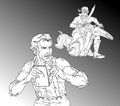Template:Selected anniversaries/July 23: Difference between revisions
No edit summary |
No edit summary |
||
| Line 18: | Line 18: | ||
||1883: Włodzimierz Stożek born ... mathematician. He published numerous papers on the theory of integral equations, potential theory, as well as on many other branches of mathematics. Pic. | ||1883: Włodzimierz Stożek born ... mathematician. He published numerous papers on the theory of integral equations, potential theory, as well as on many other branches of mathematics. Pic. | ||
||1884: Alfred Dillwyn "Dilly" Knox born ... classics scholar and papyrologist at King's College, Cambridge and a codebreaker. As a member of the Room 40 codebreaking unit he helped decrypt the Zimmermann Telegram which brought the USA into the First World War. He joined the Government Code and Cypher School (GC&CS) at the war's end. Pic search. | |||
File:Mark Twain Interviews Wallace War-Heels.jpg|link=Mark Twain Interviews Wallace War-Heels|1885: The well-known illustration ''[[Mark Twain Interviews Wallace War-Heels|Interview with Wallace War-Heels]]'' is stolen by [[math criminals]], who demand computational ransom. | File:Mark Twain Interviews Wallace War-Heels.jpg|link=Mark Twain Interviews Wallace War-Heels|1885: The well-known illustration ''[[Mark Twain Interviews Wallace War-Heels|Interview with Wallace War-Heels]]'' is stolen by [[math criminals]], who demand computational ransom. | ||
| Line 35: | Line 37: | ||
||1916: William Ramsay dies ... chemist and academic, Nobel Prize laureate. | ||1916: William Ramsay dies ... chemist and academic, Nobel Prize laureate. | ||
||1920: Mathematician, engineer, and academic Ray William Clough born. Clough was a pioneer of the finite element method (FEM). He coined the term "finite elements" in an article in 1960. Pic search | ||1920: Mathematician, engineer, and academic Ray William Clough born. Clough was a pioneer of the finite element method (FEM). He coined the term "finite elements" in an article in 1960. Pic search. | ||
File:Hans Hahn.jpg|link=Hans Hahn (nonfiction)|1934: Mathematician and crime-fighter [[Hans Hahn (nonfiction)|Hans Hahn]] publishes new analysis of set theory which soons finds application in detecting and preventing [[crimes against mathematical constants]]. | File:Hans Hahn.jpg|link=Hans Hahn (nonfiction)|1934: Mathematician and crime-fighter [[Hans Hahn (nonfiction)|Hans Hahn]] publishes new analysis of set theory which soons finds application in detecting and preventing [[crimes against mathematical constants]]. | ||
Revision as of 12:03, 22 April 2020
1754: Joseph-Louis Lagrange publishes his first work, in the form of a letter in Italian. A month later he realized that he had rediscovered Leibniz's formula for the nth derivative of a product.
1829: William Austin Burt patents the typographer, a precursor to the typewriter.
1885: The well-known illustration Interview with Wallace War-Heels is stolen by math criminals, who demand computational ransom.
1934: Mathematician and crime-fighter Hans Hahn publishes new analysis of set theory which soons finds application in detecting and preventing crimes against mathematical constants.
1928: Astronomer and academic Vera Rubin born. She will discover the discrepancy between the predicted angular motion of galaxies and the observed motion, by studying galactic rotation curves.
1962: Mathematician and crime-fighter Alice Beta uses Telstar to communicate with AESOP.
1962: Telstar relays the first publicly transmitted, live trans-Atlantic television program, featuring Walter Cronkite.
2017: AESOP re-broadcasts Walter Cronkite's 1962 trans-Atlantic television program.







